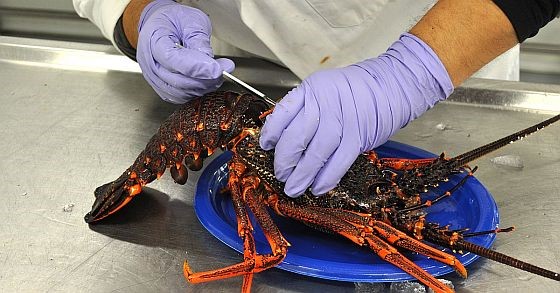
A new IMAS-led study will refine lobster monitoring tools to reduce the costs associated with biotoxin risks to the Southern Rock Lobster fishery.
Funded by the Australian Government’s Fisheries Research and Development Corporation (FRDC), the $900 000 project will build on a previous $600 000 project which introduced, calibrated, fine-tuned and fully validated a pregnancy-type rapid test kit for paralytic shellfish toxins (PST) in oysters and mussels.
Principal Investigator Professor Gustaaf Hallegraeff said the new study will support a significant improvement on the traditional approach to managing the PST risk, which involves monitoring toxin levels in wild mussels as a trigger for lobster testing.
“If toxins are found in lobsters above regulatory levels, lengthy closures of lobster fishing zones can ensue, impacting commercial and recreational lobster fishers,” Professor Hallegraeff said.
“Such closures have been affecting the $84 million per annum Tasmanian Southern Rock Lobster industry since 2012, mainly in the regions of St Helens and Maria Island where PST has been detected in the lobsters’ digestive gland (“mustard”).
“While PST has been below detection levels in the flesh of the lobster, the presence of the toxin in other tissues within the lobster, which is exported whole and alive, is sufficient to pose a significant trade barrier for key markets such as China.”
The new research will be conducted by scientists from IMAS, including Professor Hallegraeff, Professor Caleb Gardner, Dr Quinn Fitzgibbon and Dr Juan Dorantes-Aranda, and the South Australian Research and Development Institute's Alison Turnbull.
It includes the application of cheaper, faster and therefore more frequent and reliable biotoxin testing, and will explore whether rapid tests can be conducted in a non-destructive manner using blood samples.
“Concurrent tank feeding studies with lobster and Tasmanian field surveys on the variation in toxicity will help to inform the effectiveness of the current lobster fishing zones.
“Potential impact of dinoflagellate toxins on lobster vigour will also be investigated using a combination of tank exposure and blood biomarker studies,” Professor Hallegraeff said.
The project will be overseen by a steering committee of Australian and New Zealand industry representatives, domestic and export regulators, fisheries managers and the FRDC.